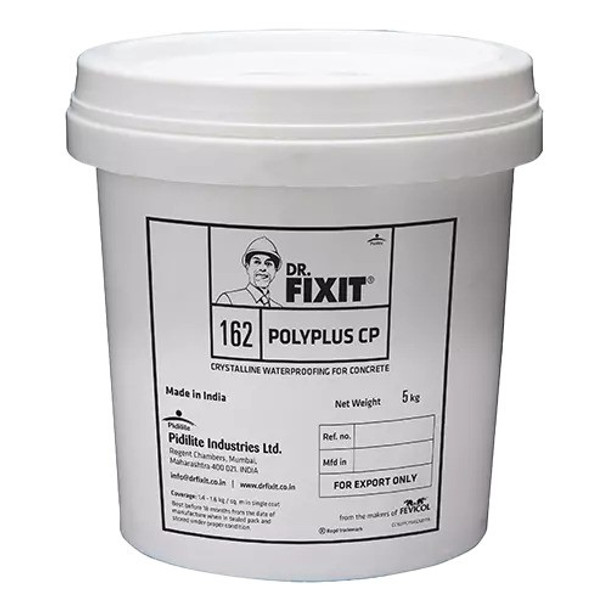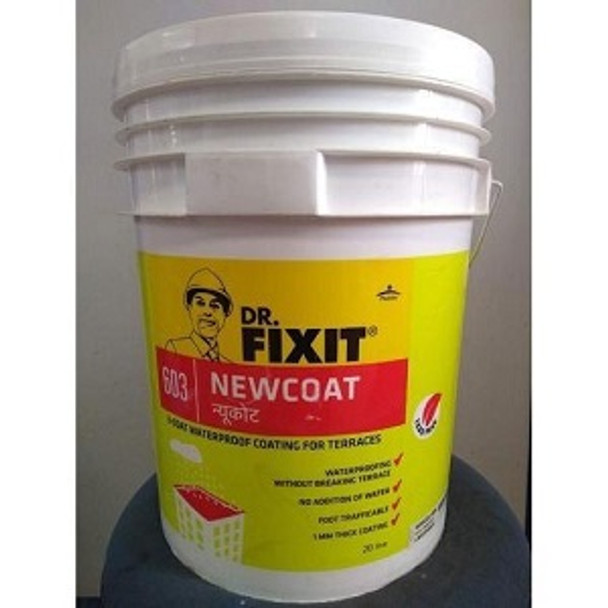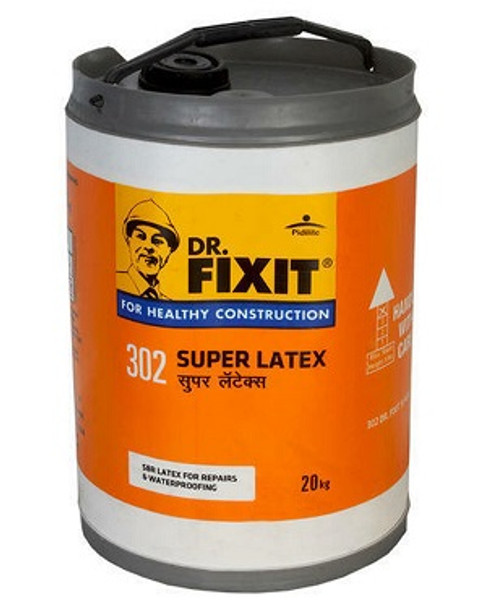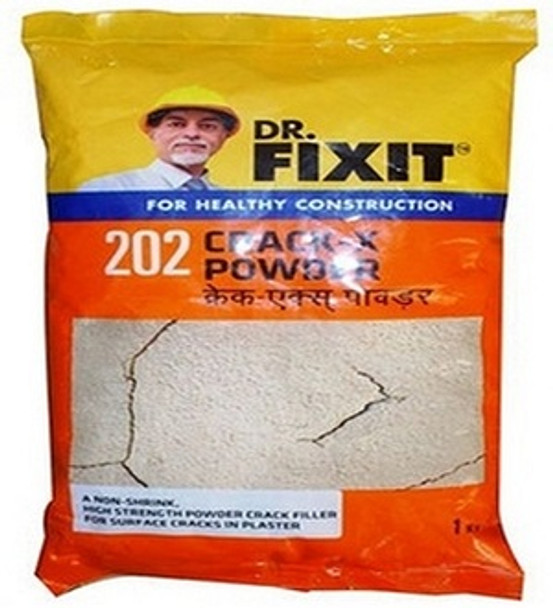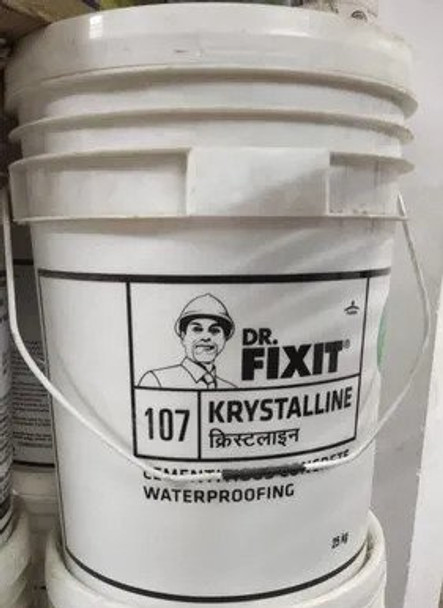Innovations in Construction Chemicals: What's New in 2024?
As the construction industry continues to evolve, so do the construction chemicals, materials, and technologies used to enhance the durability, efficiency, and sustainability of buildings and infrastructure projects.. In 2024, the world of construction chemicals is witnessing exciting advancements that promise to revolutionize the way we build. From eco-friendly additives to high-performance coatings.
Dr Fixit Polyplus CP: The ultimate solution for concrete waterproofing.
Some of these Construction chemicals include brands like Dr. Fixit which offers a wide range of innovative construction chemicals in waterproofing, building repairs, tile fixing, sealants, coatings and paints, grouts and anchors and industrial floorings. The products are easily available in cement, building materials, paints and hardware stores. Dr.Fixit offers comprehensive system solutions for Waterproofing a new home or Repairing an existing one. The product range includes wide variety of new construction and repair waterproofing solutions for all critical surface areas like Roof, External Walls, Structure, Foundation, Internal Walls, Bathrooms and Water Bodies.
This article will explore the latest innovations shaping the future of construction chemicals and their potential impact on the industry. Join us as we delve into the cutting-edge solutions driving progress and sustainability in construction projects worldwide.
99% of our readers also like: Where to Buy Construction Chemicals in Nigeria
Innovations in Construction Chemicals
1. Eco-Friendly Additives
One of the latest innovations in construction chemicals is the use of eco-friendly additives, which are substances that can modify the properties of concrete, mortar, or other building materials in a way that reduces their environmental impact. Eco-friendly additives can help to lower the carbon footprint, energy consumption, water usage, and waste generation of construction projects, while also improving the durability, performance, and aesthetics of the final products. Eco-friendly additives are becoming more popular as the construction industry faces increasing pressure to adopt sustainable practices and comply with environmental regulations.
There are many types of eco-friendly additives that can be used in construction chemicals, depending on the desired outcome and application. Some examples are:
- Recycled materials: These are additives that are derived from waste or by-products of other industries, such as fly ash, slag, glass, plastic, rubber, or wood. Recycled materials can replace some of the cement or aggregate in concrete or mortar, reducing the need for virgin materials and saving natural resources. Recycled materials can also enhance the strength, workability, and durability of the mixtures, as well as reduce the cost and weight.
- Biobased materials: These are additives that are derived from renewable sources, such as plant or animal matter, such as cellulose, starch, lignin, or proteins. Biobased materials can act as binders, fillers, fibers, or admixtures in concrete or mortar, improving the cohesion, adhesion, flexibility, and resistance of the mixtures. Biobased materials can also reduce the greenhouse gas emissions and toxicity of the mixtures, as well as increase the biodegradability and recyclability.
- Nanomaterials: These are additives that have at least one dimension in the nanoscale, such as nanoparticles, nanofibers, nanotubes, or nanosheets. Nanomaterials can modify the microstructure, chemistry, and physics of concrete or mortar, enhancing the mechanical, thermal, electrical, and optical properties of the mixtures. Nanomaterials can also improve the self-healing, self-cleaning, and sensing capabilities of the mixtures, as well as reduce the amount of cement and water needed .
Benefits And Applications Of Eco-Friendly Additives
The use of eco-friendly additives in construction chemicals can bring various benefits to the environment, the economy, and the society, such as:
- Reduced Environmental Impact: Eco-friendly additives contribute to a reduction in the environmental impact of construction activities. By using sustainable materials, the construction industry can lower the carbon dioxide emissions, energy consumption, water usage, and waste generation of construction projects, which are major contributors to global warming, resource depletion, and pollution.
- Energy Efficiency: Some eco-friendly additives enhance the energy efficiency of construction materials. For example, incorporating thermal insulating additives can improve the overall energy performance of buildings, leading to reduced energy consumption for heating and cooling.
- Compliance with Green Building Standards: As sustainability becomes a key consideration in construction projects, the use of eco-friendly additives allows builders to meet green building standards. This not only aligns with regulatory requirements but also enhances the marketability of constructed structures.
- Saving the cost and improving the quality: Eco-friendly additives can help to reduce the cost of construction materials and processes, by replacing some of the expensive or scarce components, such as cement or sand, with cheaper or more abundant alternatives, such as recycled or biobased materials. Eco-friendly additives can also improve the quality and performance of the structures, by enhancing the strength, workability, and aesthetics of the mixtures, as well as adding new functionalities, such as self-healing, self-cleaning, or sensing .
- Versatility in Applications: Eco-friendly additives are versatile and can be applied across various construction materials, including concrete, adhesives, sealants, and coatings. This versatility ensures that sustainable practices can be integrated into diverse construction processes.
Dr. Fixit 603 Newcoat… not just a coating, it adapts to the changing environmental conditions and optimizes performance and functionality.
2. High-Performance Coatings
High-performance coatings are paints that offer exceptional durability, corrosion resistance, and aesthetic appeal for various surfaces and structures. High-performance coatings are different from conventional architectural paints in that they are designed to withstand harsh environmental conditions, such as high temperatures, humidity, UV radiation, chemical exposure, and abrasion. High-performance coatings are also formulated to meet specific performance criteria, such as fire resistance, anti-fouling, anti-graffiti, or self-cleaning. They are widely used in industrial, commercial, and residential sectors, as they can enhance the structural integrity, soundness, and health impacts of buildings, building sites, and structures.
Latest Advancements In Coating Technologies
The development of high-performance coatings is driven by the increasing demand for sustainable, cost-effective, and innovative solutions for various applications and challenges. Some of the latest advancements in coating technologies are:
- Smart coatings: These are coatings that can sense and respond to external stimuli, such as temperature, pH, moisture, or electric fields, and change their properties accordingly. Smart coatings can provide functions such as self-cleaning, self-regulating, or self-reporting, which can improve the performance, durability, and safety of the coated surfaces.
- Self-Healing Coatings: Advancements in materials science have given rise to self-healing coatings. These coatings have the ability to repair minor damages autonomously, extending the lifespan of structures and reducing maintenance costs. This innovation is particularly valuable in harsh environments or high-wear areas.
- Nanocoatings: The integration of nanotechnology in coatings has revolutionized their performance. Nanocoatings are coatings that are composed of nanomaterials, such as nanoparticles, nanofibers, nanotubes, or nanosheets, which have at least one dimension in the nanoscale. They can modify the surface properties of the substrates, such as adhesion, wettability, friction, or optical characteristics, and impart new functionalities, such as antibacterial, antifouling, or superhydrophobic effects .
- Bio-based coatings: These are coatings that are derived from renewable sources, such as plant or animal matter, or produced by biological processes, such as fermentation or enzymatic reactions. Bio-based coatings can reduce the dependence on fossil fuels, lower the environmental impact, and improve the biodegradability and recyclability of the coatings.
- UV-Curing Coatings: UV-curing technology has gained traction in the construction industry. Coatings that cure instantly under UV light reduce project timelines, increase efficiency, and eliminate the need for extended drying periods. This not only accelerates construction processes but also enhances overall project productivity.
Applications And Advantages Of High-Performance Coatings
The use of high-performance coatings can bring various benefits to different sectors and applications, such as:
- Corrosion Protection: High-performance coatings excel in providing robust corrosion protection for metal surfaces, extending the lifespan of structures and reducing maintenance costs. This is particularly crucial in challenging environments, such as coastal areas with high salt exposure.
- Waterproofing and Moisture Resistance: These coatings are highly effective in preventing water ingress and protecting structures from moisture-related damage. Applications range from waterproofing foundations to moisture-resistant coatings for interior spaces, ensuring long-term structural integrity.
- Chemical Resistance: In industrial settings, high-performance coatings with advanced chemical resistance properties are applied to protect surfaces from corrosive substances. This is vital in facilities where exposure to chemicals is a constant concern
- Enhanced Aesthetics: Beyond their protective functionalities, high-performance coatings contribute to the aesthetic appeal of structures. They come in a variety of finishes, colors, and textures, allowing architects and builders to achieve both functional and visually pleasing outcomes.
Dr. Fixit 302 Super Latex... A versatile product used for repairing spalled concrete, fixing tiles and stones, waterproofing toilets and terraces, and bonding old and new concrete and plaster.
3. Sustainable Concrete Solutions
Concrete is one of the most widely used materials in the construction industry, but it also has a significant environmental impact, as it consumes a lot of natural resources and emits a lot of carbon dioxide during its production. Sustainable concrete solutions aim to reduce the negative effects of concrete on the environment, while maintaining or improving its performance and functionality.
Innovations In Concrete Additives And Admixtures
One of the main ways to achieve sustainable concrete solutions is to use innovative additives and admixtures that can modify the properties and behavior of concrete, such as its strength, workability, setting time, or curing process. Additives and admixtures can also reduce the amount of cement or water needed in the concrete mix, which can lower the environmental impact and cost of concrete production. Some examples of innovative additives and admixtures are:
- Recycled materials: The incorporation of recycled materials is a key innovation in sustainable concrete production. These materials are obtained from demolished structures or industrial by-products, such as crushed concrete, fly ash, slag, glass, plastic, rubber, or wood. Recycled materials can replace some of the cement or aggregate in concrete and also enhance the strength, workability, and durability of concrete, as well as reduce the cost and weight.
- Bio-based materials: These are materials that are derived from renewable sources, such as plant or animal matter, or produced by biological processes, such as fermentation or enzymatic reactions. Bio-based materials can act as binders, fillers, fibers, or admixtures in concrete, improving the cohesion, adhesion, flexibility, and resistance of concrete. Bio-based materials can also reduce the greenhouse gas emissions and toxicity of concrete, as well as increase the biodegradability and recyclability.
- Carbon Capture Technology: Innovations in carbon capture technology are being applied to concrete production, capturing carbon dioxide emissions and converting them into beneficial materials within the concrete mix. This approach improves the environmental impact of concrete while contributing to carbon removal efforts.
Impact Of Sustainable Concrete Solutions On Construction Projects
The use of sustainable concrete solutions can bring various benefits to construction projects, such as:
- Reducing the environmental impact: Sustainable concrete solutions can help to lower the carbon dioxide emissions, energy consumption, water usage, and waste generation of construction projects, which are major contributors to global warming, resource depletion, and pollution. Sustainable concrete solutions can also increase the lifespan, durability, and resilience of the structures, reducing the need for maintenance and replacement .
- Long-Term Economic Benefits: While initial costs for sustainable concrete solutions may sometimes be slightly higher, the long-term economic benefits are notable. Reduced maintenance, extended lifespan of structures, and compliance with evolving environmental regulations contribute to cost savings over the life cycle of a construction project.
- Creating new opportunities and markets: The use of sustainable concrete solutions can help to create new opportunities and markets for the construction industry, by enabling the development of innovative and customized solutions for different needs and challenges, such as green buildings, smart cities, or disaster recovery. Sustainable concrete solutions can also stimulate the growth and competitiveness of the industry, by fostering the collaboration and integration of different sectors, such as waste management, biotechnology, or nanotechnology.
Dr. Fixit 202 Crack-X Powder is a polymer-modified powder that bonds strongly to the surface and prevents cracking, dusting, and leakage.
4. Smart Construction Chemicals
The integration of smart technologies in the construction industry has paved the way for innovative solutions known as smart construction chemicals. Smart construction chemicals are those that can sense and respond to external stimuli, such as temperature, pH, moisture, or electric fields, and change their properties accordingly. These intelligent additives and materials leverage advancements in technology to enhance the efficiency, performance, and sustainability of construction projects.
There are many types of smart technologies that can be used in construction chemicals, depending on the desired outcome and application. Some examples are:
- Shape memory alloys: These are alloys that can change or deform their shape (when stress is applied) and then return to their original shape (when heat is applied). The superelasticity properties can be particularly useful to improve the structural behavior of bridges and buildings after an impactful event like an earthquake.
- Sensors and IoT Integration: The incorporation of sensors and Internet of Things (IoT) technology enables real-time monitoring of structural health. Smart construction chemicals equipped with sensors can provide data on factors like temperature, humidity, stress, and strain, allowing for proactive maintenance and early detection of potential issues.
- Adaptive Coatings: Coatings with adaptive properties, such as color-changing or self-cleaning capabilities, fall under the category of smart construction chemicals. These coatings can respond to external stimuli like UV light or moisture, providing dynamic functionalities to enhance both aesthetics and performance
- Bio-based coatings: These are coatings that are derived from renewable sources, such as plant or animal matter, or produced by biological processes, such as fermentation or enzymatic reactions. Bio-based coatings can reduce the dependence on fossil fuels, lower the environmental impact, and improve the biodegradability and recyclability of the coatings. Bio-based coatings can also offer advantages such as low toxicity, high biocompatibility, and enhanced performance.
Benefits And Future Prospects Of Smart Construction Chemicals
The use of smart construction chemicals can bring various benefits to the construction industry, such as:
- Enhanced Durability and Longevity: The incorporation of smart construction chemicals contributes to increased durability and longevity of structures. Self-healing materials and adaptive coatings reduce the impact of environmental factors, leading to structures that can withstand the test of time.
- Cost-Efficiency through Predictive Maintenance: The real-time monitoring capabilities of smart construction chemicals enable predictive maintenance. By detecting issues early on, construction professionals can address potential problems before they escalate, resulting in cost savings through efficient maintenance practices.
- Improved Safety: Smart construction chemicals enhance safety on construction sites by providing real-time data on structural conditions. This proactive approach to monitoring helps prevent accidents and ensures that structures meet or exceed safety standards throughout their lifecycle.
- Environmental Sustainability: Many smart construction chemicals contribute to environmental sustainability by optimizing energy usage and reducing waste. The incorporation of adaptive materials and technologies aligns with the broader goal of creating eco-friendly and resource-efficient construction practices.
- Future Prospects: The future of smart construction chemicals holds promising developments, including further integration with artificial intelligence, machine learning, and advanced robotics. These technologies will likely lead to even more sophisticated and autonomous construction processes, further revolutionizing the industry.
Dr Fixit Krystalline 107 is a versatile product that can be used for waterproofing water-retaining and water-excluding structures, such as tanks, pipes, foundations, and tunnels.
Related Article
What are Construction Chemicals ?
Conclusion
Construction chemicals are essential components of the construction industry, as they can improve the quality, performance, and durability of building materials and structures. However, construction chemicals also have a significant environmental impact, as they consume a lot of natural resources and emit a lot of carbon dioxide during their production and use. Therefore, it is important to embrace innovation and adopt sustainable practices in the development and application of construction chemicals.
In this article, we have discussed some of the latest innovations in construction chemicals, such as eco-friendly additives, high-performance coatings, sustainable concrete solutions, and smart construction chemicals. These innovations can help to reduce the negative effects of construction chemicals on the environment, while maintaining or enhancing their functionality and functionality. These innovations can also bring various benefits to the construction industry, such as reducing the cost, saving energy, creating new opportunities, and stimulating growth.
The future of construction chemicals is promising, as more research and development are being conducted to explore new materials, processes, and technologies that can offer better solutions for different needs and challenges. The future of construction chemicals is also dependent on the collaboration and integration of different sectors, such as waste management, biotechnology, nanotechnology, or information technology, which can provide new insights and resources for innovation.
The construction industry is one of the largest and most influential sectors in the world, as it affects the economy, the society, and the environment. Therefore, it is crucial to embrace innovation and adopt sustainable practices in the development and application of construction chemicals, as they can contribute to the well-being and development of the present and future generations. For More information or if you have any questions or Enquiries feel free to CONTACT US @ gz-supplies.com


